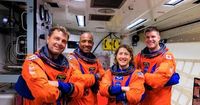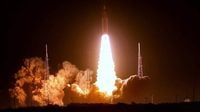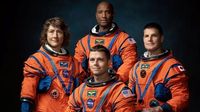NASA’s Artemis II mission, set for launch as early as February 2026, is poised to become the first crewed journey around the Moon in half a century—a bold leap that could reshape humanity’s relationship with space. The four-member crew, each breaking new ground in their own way, will circle the Moon in their spacecraft ‘Integrity,’ venturing farther from Earth than any human has before. The mission, a critical step in the Artemis program, aims to pave the way for future lunar landings and the eventual establishment of a long-term base on the Moon’s surface.
Commander Reid Wiseman, speaking at a recent NASA news conference, captured the spirit of exploration: “We will see things that no human has ever seen.” He explained that Artemis II will fly over vast lunar regions never mapped by the Apollo missions, offering fresh vistas and scientific opportunities. The crew’s excitement is palpable, and for good reason—this is a moment that echoes the legendary Apollo missions, but with a distinctly 21st-century twist.
Mission specialist Christina Koch, who will make history as the first woman to travel to the Moon, emphasized the unique value of human observation. “Believe it or not, human eyes are one of the best scientific instruments that we have,” she said. Koch, who spent 328 consecutive days in space in 2019 and participated in the first all-female spacewalk, is no stranger to breaking barriers. She’s keenly aware of the mission’s potential to inspire: “Our geologists are beyond excited for our eyes to look at the Moon, and we’ve been training how to turn those observations into answering some of the biggest questions of our time, questions like ‘Are we alone?’” According to Koch, Artemis II is the first step toward answering such cosmic mysteries, with Mars exploration on the distant horizon.
The Artemis II crew, which also includes Canadian astronaut Jeremy Hansen and NASA’s Victor Glover, reflects the program’s commitment to diversity and international cooperation. Hansen, a fighter pilot and physicist, will become the first non-American to travel to the Moon. He draws inspiration from the Apollo 8 mission of 1968, recalling how, during a turbulent era, the sight of Earth from lunar orbit “saved 1968” for many. “The Artemis missions have set such an ambitious goal for humanity that is inspiring contributions from around the World, not just one nation is inspired and moved by this, but nations around the globe are coming together,” Hansen told reporters.
Victor Glover, set to become the first black person to orbit the Moon, brings a sense of purpose and perspective. “Pushing ourselves to explore is core to who we are,” he said in a NASA interview. “It is part of being human.” Glover, who previously piloted NASA’s SpaceX Crew-1 mission, holds three master’s degrees and is known for his charismatic leadership—his call sign, “IKE,” is a nod to his reputation for expertise. Glover’s words harken back to President John F. Kennedy’s famous call to action: “We choose to go to the moon in this decade and do the other things, not because they are easy, but because they are hard.”
The Artemis II mission will last ten days and take the crew up to 9,000 miles beyond the Moon, farther than any previous human voyage. Although they won’t land, the astronauts will spend three hours studying the lunar surface in unprecedented detail, using their own eyes and scientific instruments to collect data and observations. According to The i Paper, the mission will also conduct scientific experiments to study how humans respond to low gravity and cosmic radiation—vital knowledge for the longer journeys to Mars that NASA envisions.
But why return to the Moon now, after a 50-year hiatus? As The i Paper’s Clare Wilson notes, the original Apollo program was driven by Cold War rivalry and national pride. Once the U.S. had beaten the USSR to the Moon, the immense cost of lunar missions became harder to justify, and the program fizzled out. Since then, NASA has faced budget battles and the fallout from two space shuttle disasters, leading to several false starts. The Artemis program, initiated under President Donald Trump and continued by President Joe Biden, has weathered its own share of delays and funding cuts. Earlier this year, NASA’s budget was slashed by a quarter, sparking outrage among scientists—but the Artemis missions were spared, with other projects taking the hit.
National pride remains a powerful motivator. Trump, according to The i Paper, has made it clear he wants Americans back on the Moon before China or Russia. The geopolitical stakes are real: China landed a spacecraft on the Moon’s far side in 2019 and brought back soil samples in 2024, with plans for a joint China-Russia lunar base. Both the U.S. and its rivals are racing to establish a base near the lunar south pole, with NASA announcing that its outpost will be powered by a nuclear reactor—a move mirrored by China and Russia.
For the Artemis II astronauts, the mission is about more than politics. It’s about reigniting the spirit of discovery and inspiring a new generation. Koch, who was inspired by the famous “Earthrise” photo from Apollo 8, hopes her journey will have a similar impact. “The fact that it was a human behind that lens made that picture so much more profound and changed the way we thought of our own home,” she reflected. Hansen, too, sees the mission as a beacon of unity in challenging times. “When they flew around the Moon just before Christmas in 1968 there was a lot going on the world, and people realised it was a really tough time. People were struggling in many different ways and I think we can all resonate with that today.”
The Artemis II crew chose the name ‘Integrity’ for their spacecraft, a nod to their shared vision. “Peace and hope for all humankind, that is what we really want. We are bringing together the world, and when you squeeze it all down, it will create magic,” said Wiseman. His hope is that Artemis II will be remembered as “a tiny step in having humans on Mars and a sustained presence on the Moon”—words reminiscent of Neil Armstrong’s legendary “one small step for man, one giant leap for mankind.”
Beyond the symbolism, Artemis II is expected to yield practical benefits. According to Dr. Sarah Casewell of the University of Leicester, “The idea that we’re putting people back on to the moon is really exciting and aspirational for a young generation of people.” She and other scientists argue that, while robotic missions are cheaper and less risky, humans are better at collecting samples and making on-the-spot decisions. Professor Mahesh Anand of the Open University agrees: “Humans go around and pick up samples that they find interesting. The speed at which you can do the work is more rapid than trying to use a rover that walks along the surface.”
NASA’s Artemis program is not just about exploration—it’s about preparing for the future. The knowledge gained will help scientists understand the Moon’s geology, the formation of the solar system, and life’s place in the universe. As Dr. Casewell puts it, “It’s all part of trying to understand our part in the universe, why are we here and how did life form.” The mission’s legacy, like Apollo’s, may well be measured in both scientific breakthroughs and the dreams it inspires.
As the Artemis II crew—Christina Koch, Jeremy Hansen, Victor Glover, and Reid Wiseman—prepare for their historic voyage, they’re carrying not just scientific instruments, but the hopes of a world looking skyward once again. Their message is simple, yet profound: “We are ready. We are going. To the Moon. For all humanity!”






